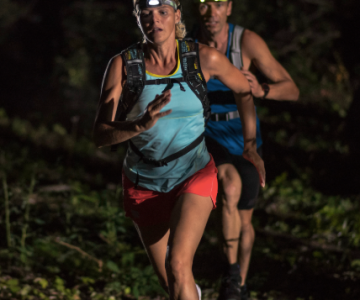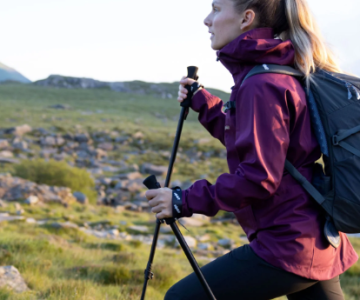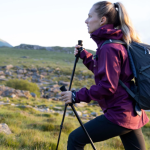Trekking poles are one of those pieces of gear that can spark a lot of debate. Some love them, some hate them. Regardless of where you stand on the issue, it’s undeniable that poles offer tangible benefits in certain conditions. Whether you’re a trail runner, a hiker, or a fastpacker, knowing when and how to use trekking poles can make your time on the trail more comfortable and efficient.
The Benefits of Trekking Poles
Uphill Efficiency
Trekking poles really shine when you’re climbing steep hills. They don’t make you run faster, but they help you conserve energy by allowing your arms to assist in the upward motion. This reduces the strain on your legs and allows you to stand taller, preventing the fatigue that comes from leaning into steep inclines. It’s like having an extra set of muscles to help you push through the climb.
Additional Support on Downhills
On descents, poles can provide valuable support by allowing you to control your descent and reduce the jarring impact on your joints. This is especially helpful when carrying a heavy backpack. However, for trail runners, poles may not always be as useful during downhill sections. If the trail is technical or narrow, you might not have time to plant the poles properly, which can lead to tripping or breaking them. But in certain situations, like crossing boulders or loose gravel, poles can still offer help.
Better Balance on Technical Terrain
When dealing with tricky terrain, trekking poles become incredibly useful. On icy or slippery trails, they give you something extra to lean on and help you keep your balance. They are particularly helpful when crossing streams, allowing you to probe the water and assess its depth and flow before you step in. This can prevent accidents and save your gear from getting wet. If you’re planning on crossing rivers or streams, poles should definitely be part of your gear list.
Protection from Nasty Plants
Trekking poles can also act as a buffer between you and unpleasant vegetation like poison ivy, stinging nettles, or thorns. You can use them to push the plants aside as you move through, making the trail more comfortable. While some may consider using poles to fend off aggressive wildlife, it’s essential to understand that the best approach to animal encounters is to avoid confrontation and know how to handle wildlife safely.
Personal Space in Crowded Races
In a crowded race, poles can provide a little extra personal space. They help create distance between you and others, especially when the trail is tight. Poles also make it easier to deflect stray sticks or poles from other runners, providing some protection against pole clashes. However, unless you’re in a race, the need for this kind of space is unlikely to justify the extra weight.
Multi-Purpose Use for Tarp Rigging
One of the great things about trekking poles is their versatility. Many ultralight shelters and tarps can be rigged using trekking poles instead of carrying dedicated tent poles. This can save weight, which is essential for fastpackers and thru-hikers who want to minimize their load. By using your trekking poles to set up your shelter, you can carry less while still ensuring a secure place to sleep.
The Drawbacks of Trekking Poles
Becoming Dependent on Them
The biggest risk of using trekking poles, especially for runners, is becoming too reliant on them. It’s easy to get lazy and start using poles even when you don’t need them. Overusing poles for balance, for example, can interfere with your natural movement and core strength. If you rely on poles too much, you might lose some of the benefits of using your body’s own balance and coordination. It’s important to remember that poles should complement your movement, not replace it.
Extra Weight to Carry
The most obvious downside of trekking poles is that you have to carry them when they’re not in use. For trail runners, this can be especially annoying during flat sections of the trail where poles don’t provide much benefit. You’ll need to figure out a way to attach them to your pack or vest, which can sometimes make eating or reaching for items more difficult. If you’re a hiker, you might have to take off your pack to stow your poles when you don’t need them.
Increased Energy Expenditure
For hikers, using poles all the time can lead to unnecessary energy expenditure. Although poles help on steep ascents, using them during easier sections can make your arms more tired, especially if you’re carrying a heavy pack. Lifting poles with every step takes energy, and over the course of a long hike, that extra load on your arms can add up. Many hikers find that poles are more useful on the steeper sections of a trail and less necessary when the terrain flattens out.
Environmental Impact
While trekking poles are helpful, they do have an environmental impact. The metal carbide tips can scar rocks and harm the delicate soil and plants on trails. Even rubber tips can leave small holes in softer areas of the trail. Popular trails can become scarred over time due to the cumulative effect of trekking pole use. To minimize this impact, consider using rubber tips and removing your poles when you don’t need them.
When Should You Use Trekking Poles?
Trail Running
Trail runners typically prefer to run without poles but may choose to use them on trails with sustained uphill sections or during river crossings. Poles can be particularly helpful on slippery or icy trails, but they’re less useful when the trail requires scrambling or technical maneuvers. In those situations, poles can get in the way. If you’re a runner, consider carrying poles for steep ascents or when crossing unstable terrain but leave them behind during flat sections or when navigating technical rock features.
Hiking
For hikers, whether you should use poles depends largely on the weight of your pack and the difficulty of the terrain. When carrying a heavy pack, poles can provide stability and help with balance, especially on steep or rugged trails. On easier, flatter hikes, poles are less necessary and can actually add to your fatigue. If you’re using trekking poles for shelter setup or river crossings, they can also serve dual purposes.
How to Properly Use Trekking Poles
To get the most out of your trekking poles, make sure they’re the right size for you. A good rule of thumb is to ensure that your elbows form a 90-degree angle when holding the poles with the tips on the ground near your feet. Your arms should be comfortably angled backward at about 70 degrees. When using poles, hold them by the grips and make sure to use the straps correctly—slip your hand through the strap, then grip the pole. This helps reduce hand strain and keeps the pole secure even when you aren’t holding it tightly.
When moving with poles, try to sync their movement with your stride. Alternate your legs and poles in a natural rhythm (right foot, left pole forward, and vice versa). If you’re power-hiking or dealing with obstacles, double planting (placing both poles forward at once) can help give you extra leverage.
Adjusting the Pole Length
One of the advantages of adjustable poles is that you can lengthen or shorten them depending on the terrain. For uphill sections, consider shortening your poles to improve leverage. For downhill sections, lengthen them slightly to prevent stooping and help maintain a balanced posture.
Conditioning for Pole Use
Using trekking poles effectively requires some upper-body strength. If you’re not used to upper-body exercise, it may take time to build up the necessary muscle strength to handle the extra load. Regular practice is key to developing the strength and coordination needed to make poles an asset rather than a burden.
Conclusion
Trekking poles are incredibly useful in certain conditions, but they aren’t necessary all the time. Knowing when to use them—on uphill sections, during river crossings, or on technical descents—will make them a valuable tool in your outdoor adventures. Always consider the terrain, your gear, and your physical condition when deciding whether to carry or use poles.





